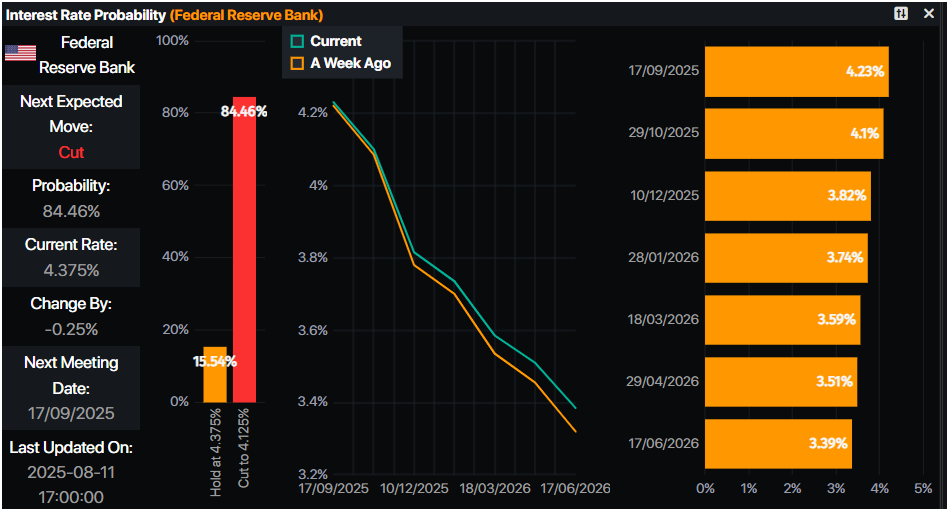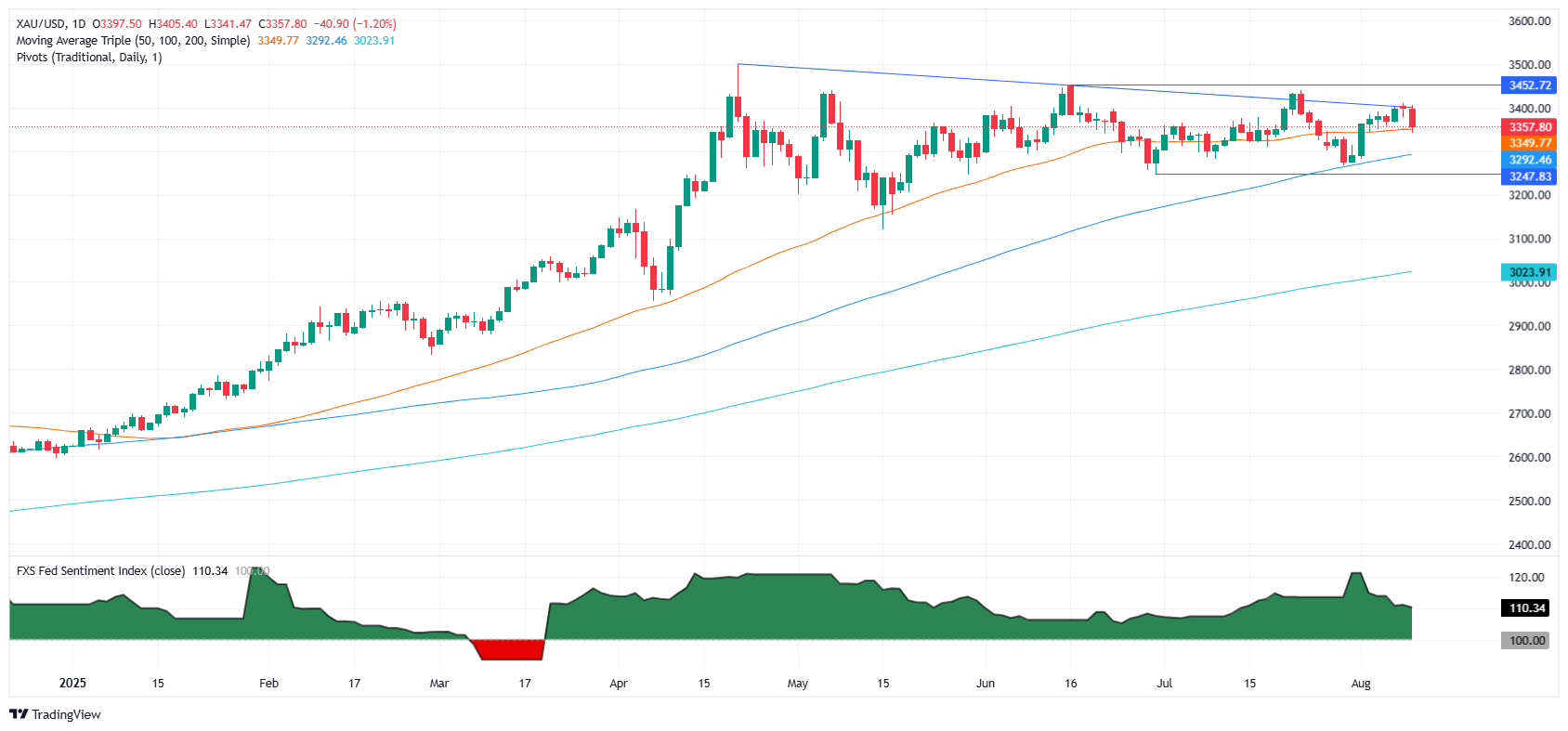- XAU/USD down 1.20%, trading at $3,356 during North American session.
- US President Donald Trump said that Gold will not be tariffed.
- Anticipation builds for Trump–Putin meeting, potential Ukraine truce plan weighs on safe-haven demand.
- July US CPI expected at 2.8% YoY; Core CPI projected above 3% for first time since February.
Gold price dives during the North American session as traders waited for the White House resolution on duties over physical Bullion bars, which triggered a downturn last Friday in the futures market. Traders awaiting the release of inflation data in the United States (US) pushed spot prices down. At the time of writing, XAU/USD trades at around $3,360, down over 1.20%.
Demand for Gold took a hit due to speculation that the meeting between US President Donald Trump and his Russian counterpart, Vladimir Putin, on Friday could unveil a truce plan in Ukraine. The recovery of the US Dollar amid falling US Treasury yields drove Bullion prices below the $3,400 mark.
On Tuesday, the US Bureau of Labor Statistics (BLS) is expected to release the Consumer Price Index (CPI) for July. Estimates suggest that headline inflation would be at around 2.8% YoY, up from June’s 2.7%. Core CPI is projected to rise above the 3% threshold for the first time since February 2025.
US President Donald Trump posted on his social network that Gold will not be tariffed.

Ahead this week, the US economic calendar will feature the release of inflation on the producer front, jobless claims, Industrial Production data, Retail Sales and the University of Michigan Consumer Sentiment for August. Alongside this, speeches by Federal Reserve (Fed) officials will be scrutinized.
Daily digest market movers: Busy US economic docket to drive Gold prices
- The current week’s economic data will be eyed following the latest jobs data, which has shown signs of cracking. However, if the July CPI rises, Fed officials’ reaction to the data will be crucial. If they stress that price stability would be the priority, this could drive Gold prices lower. Otherwise, if the disinflation process progresses, then Bullion might be headed higher as US yields are expected to drop.
- Following CPI, traders will also eye the evolution of the labor market and consumer spending via Retail Sales, which are expected to dip from 0.6% to 0.5% MoM in July. The week will end with the release of US Consumer Sentiment, which is projected to improve from 61.7 to 62 in August’s preliminary reading.
- The US Dollar Index (DXY), which tracks the performance of the buck’s value against a basket of its peers, is up 0.26% at 98.52. The US Dollar’s recovery capped Gold’s advance toward $3,400.
- The US 10-year Treasury note yield is down two basis points, sitting at 4.265%.
- Fed Interest Rate Probabilities show that traders have priced in an 84% chance of a 25 bps rate cut at the September meeting, according to Prime Market Terminal data.

Source: Prime Market Terminal
Technical outlook: Gold price tumbles and tests confluence of 20/50-day SMAs
Gold dropped below $3,380 after clearing the bottom of the $3,380-$3,400 trading range set on Friday, which drove XAU/USD toward a daily low of $3,341. Despite this, the yellow metal remains upwardly biased as it tests the confluence of the 50-day and 20-day at around $3,356/$3,349, with buyers eyeing $3,380.
If XAU/USD climbs above $3,400, the next area of interest would be the June 16 peak at $3,452, followed by the record high of $3,500. Conversely, if Gold ends the day below $3,350, Bullion could slide toward the 100-day SMA at $3,283.

Gold FAQs
Gold has played a key role in human’s history as it has been widely used as a store of value and medium of exchange. Currently, apart from its shine and usage for jewelry, the precious metal is widely seen as a safe-haven asset, meaning that it is considered a good investment during turbulent times. Gold is also widely seen as a hedge against inflation and against depreciating currencies as it doesn’t rely on any specific issuer or government.
Central banks are the biggest Gold holders. In their aim to support their currencies in turbulent times, central banks tend to diversify their reserves and buy Gold to improve the perceived strength of the economy and the currency. High Gold reserves can be a source of trust for a country’s solvency. Central banks added 1,136 tonnes of Gold worth around $70 billion to their reserves in 2022, according to data from the World Gold Council. This is the highest yearly purchase since records began. Central banks from emerging economies such as China, India and Turkey are quickly increasing their Gold reserves.
Gold has an inverse correlation with the US Dollar and US Treasuries, which are both major reserve and safe-haven assets. When the Dollar depreciates, Gold tends to rise, enabling investors and central banks to diversify their assets in turbulent times. Gold is also inversely correlated with risk assets. A rally in the stock market tends to weaken Gold price, while sell-offs in riskier markets tend to favor the precious metal.
The price can move due to a wide range of factors. Geopolitical instability or fears of a deep recession can quickly make Gold price escalate due to its safe-haven status. As a yield-less asset, Gold tends to rise with lower interest rates, while higher cost of money usually weighs down on the yellow metal. Still, most moves depend on how the US Dollar (USD) behaves as the asset is priced in dollars (XAU/USD). A strong Dollar tends to keep the price of Gold controlled, whereas a weaker Dollar is likely to push Gold prices up.

